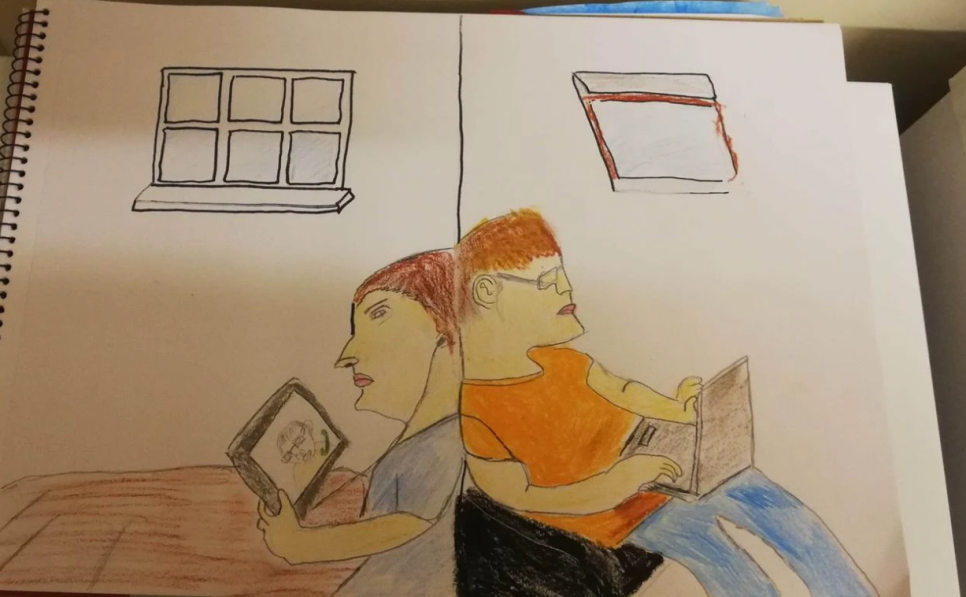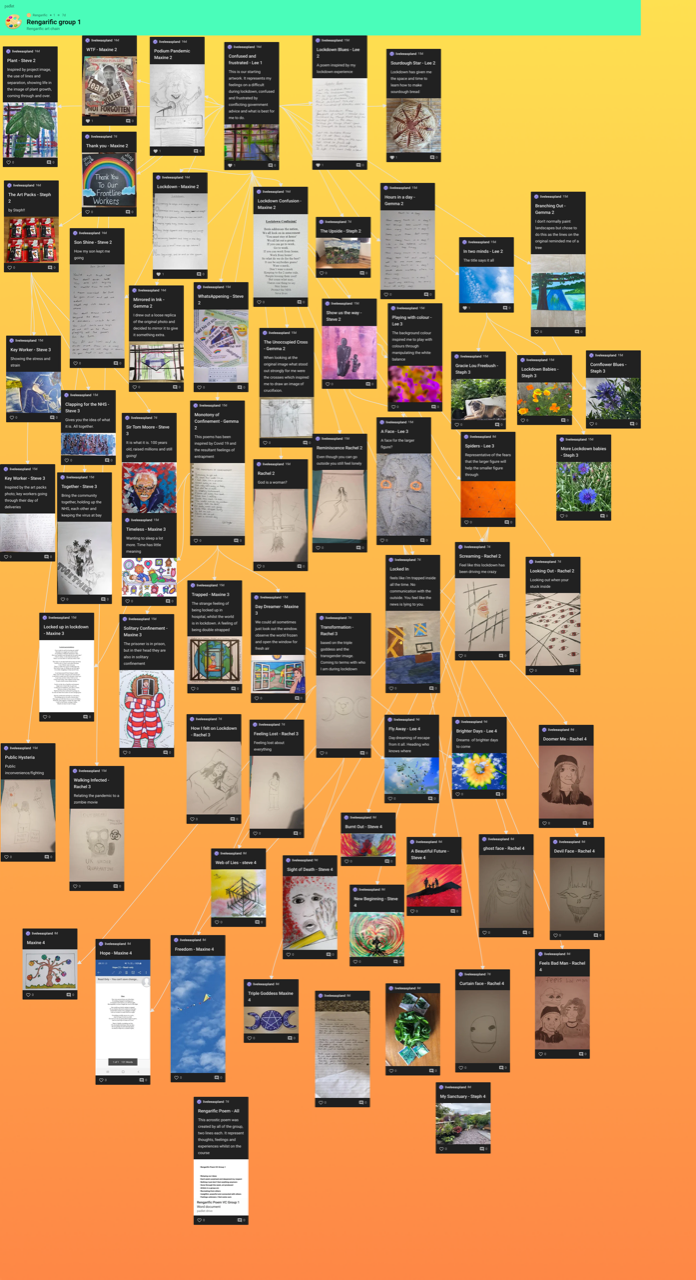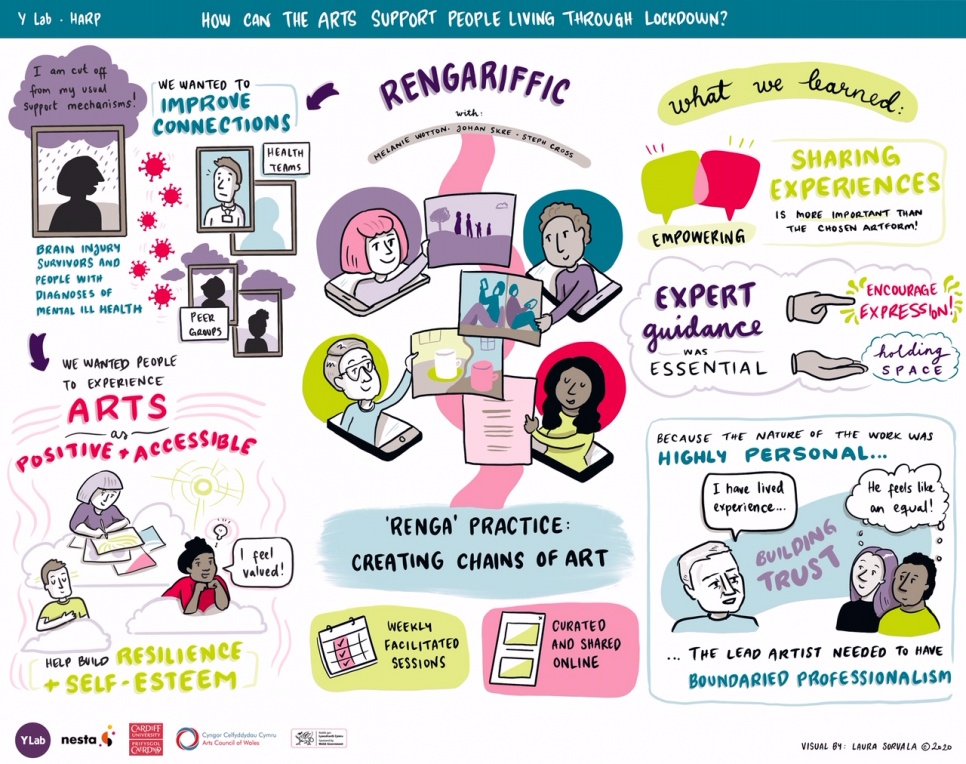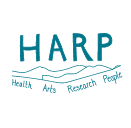Steph Cross, project manager at The VC Gallery; Johan Skre, arts on prescription manager, Swansea Bay University Health Board; and Melanie Wotton, arts in health project manager, Cardiff and Vale University Health Board.

Aim: To provide community members with a creative outlet, building both social and artistic links between people with similar experiences. The act of sharing one’s creative works builds resilience and ability to cope with the effects of the pandemic.
Activity: Supporting two groups of adults experiencing mental health problems and a third group of brain injury survivors, to access creativity from home by creating story chains (‘rengas’) of visual art and creative writing that were inspired by each other's work (‘riffs’) and charted their feelings about lockdown and the pandemic.
What need were you seeing in the world that motivated you to embark on the HARP Sprint challenge?
With the onset of Lockdown due to the COVID-19 crisis, many vulnerable adults found themselves disconnected from their usual support networks and interaction mechanisms, and in need of a focus on a day to day basis. Healthcare teams were redeployed and unable to offer their regular face to face, community or day clinic support roles, initially providing just basic support, and many community support venues were closed. This meant they became very worried about their patients’ or members’ wellbeing; engagements were limited to telephone calls and/or video. In particular we identified two particular groups to work with:
- People with mental health lived experience living in the communities in South and West Wales (some of these are normally supported by community organisation The VC Gallery, but not all)
- Brain injury survivors who usually attend the Hafan Y Coed day centre in Cardiff and Vale University Health Board, but couldn’t during lockdown.
What did you want your contribution to be? What were your goals, hopes and dreams for your participants?
- We wanted to improve connections between peer groups using creative activities so that groups can share in a safe, non-judgemental space.
- We wanted participants to be able to view the arts as a positive experience that is accessible to all - shifting the view that some may hold that arts are elitist.
- We hoped that participants could build their resilience, self esteem to feel more confident and valued, and less anxious.
What did you do and why?
We considered arts interventions which could inspire participants and lead to increased social interaction, peer support and empowerment, and which could be delivered safely online. We developed a flexible, easy to access arts intervention, Rengarific, based on a chain of related artistic responses, which could be peer-led. We employed an artist to facilitate a ‘Renga’ creative practice with groups via online group video calls. The sessions were facilitated by Lee Aspland, an artist who was shielding himself at the time. Following the Renga story-chain form, Lee began by giving each group a photograph he took that displayed his experience during lockdown, which he also described from a personal perspective. Members of the group then went away from the first group session to ‘riff’ off his photo, using it as inspiration to create chains of art that told their experiences and stories, which were then curated and shared using the Padlet platform.
In total there were four facilitated weekly group sessions for each of the three groups taking part, at which participants shared their work and described the process/motivations behind the works. During weeks two, three and four they then ‘riffed’ off each other, choosing artworks by other participants that motivated them and creating more work linked to those. For the VC Gallery groups, Steph attended to provide pastoral care. For the Hafan Y Coed groups, for safeguarding reasons, Lee provided initial video instructions and the live sessions were then facilitated by staff members from the Neuropsychiatry team including a practicing artist, who facilitates the face to face art sessions in the day centre and is well known to the group.
The artist gave participants a lot of freedom in which art form they wanted to use and which subjects, although most chose painting/drawing, photography or poetry/creative writing on the theme of the pandemic. Art works will be exhibited, first online and then later via a physical exhibition at The Hearth Gallery, University Hospital Llandough.

What did you learn about the artform/s you chose and how people engaged with it?
In a way, the artform in Rengarific is secondary to the process - it was about sharing experience through the artform they choose. However, it worked particularly well to give participants the option of using any artform they wanted to, as it took the pressure off people to be good at a single art form and the choice was empowering for them. It also strengthened the links between them; one participant might write a poem, then another might use the words from that poem that stood out to them to create a painting, incorporating their words. It was very powerful as it showed both the differences in perspective around lockdown, but also the similarities in experience which made people feel less alone.
It was very important to find an artist who was able to connect with others in the right way
in this setting. The highly personal nature of the creative engagement meant that a high degree of boundaried professionalism was needed from Lee, but also that he himself had lived experience of a health condition that they could share so that it felt like an equal experience. Lee’s sharing of his personal story was a key catalyst for building trust and inspiring the groups. The tailoring of the project to this group highlighted the need for deeper staff and artist collaboration and preparation, particularly for vulnerable groups.

What did you learn about how people access arts activities for their wellbeing at this time?
For The VC Gallery groups, most of the participants in Rengarific were already known to the Gallery; we found it was much harder to recruit people who weren’t already connected to us, which surprised us. Their prior engagement meant most participants also had experience of creating art works, though this wasn’t necessary (and the team supplied high quality art packs to all participants).
The Hafan Y Coed (HYC) brain injury survivors group were unknown to us and contact with this vulnerable group of participants had to be managed carefully through the HYC team. It worked, because the participants trusted the HYC team and the health board took on full responsibility for the programme within its own structures. The team were therefore very reliant on the enthusiasm and engagement of the HYC staff members and their commitment to the project, The HARP Sprint provided a momentum to set up virtual arts sessions in support of this vulnerable group. We relied on the ability of the staff members to set up risk assessments for each individual, to write consent forms applicable to this vulnerable group, and to help set up new Zoom procedures for the adult mental health services. They were keen to provide an innovative solution to support their patients, which Rengarific delivered, and we were able to support them with regular meetings, art materials and online access to the display system to help the HYC team feel confident. Being able to overcome these challenges for this project meant that the HYC staff members could then use these processes for other sessions and projects to help more isolated patients and staff, and sessions have continued in the same format.

Feedback from the HYC team has been positive:
“Prior to lockdown we ran a variety of weekly support groups including a creative project group. Lockdown inevitably brought this to a halt along with some of the benefits that came with it i.e. an opportunity for peer support, social connection, cognitive stimulation as well as creative thinking and exploration.
When Melanie extended the invitation for us to participate in the virtual art project we were thrilled and saw the potential benefits the opportunity had to offer.
The general consensus is that the project has provided a focus in a time where usual routines have been disrupted. In doing so it has enhanced creative expression, social connectedness and uplifted mood. One of the members wrote. ‘The group got me out more and interacting with things during lockdown which brought my mood up’. They went on to describe how it had been a welcome change from the negativity reported in the news.
Another member described how they had been encouraged to explore different avenues of creative medium, they wrote “I have become more confident with paint and pastels as I never believed I could paint or draw”. The supply of art materials from the charity was very welcomed and allowed the participants to get started with the project.
Although challenging for some at first, the sessions allowed people to improve their technological skills. One of our members initially required assistance to access the sessions however by the end of the project had become more competent and able to use the video platform independently.
The project was so well received that once the 4 weeks came to an end, the group requested that the sessions continue and they are still just as enthusiastic about creating art and engaging in discussions around it.
We are thankful to have been given the opportunity to take part.”
What participants have got from this activity?
Participation at the sessions / attendance has been very good, with participants engaging well and creating dozens of powerful artworks - poems, pictures and photographs. Many have followed a lockdown theme, reflecting feelings of being trapped, in an unfamiliar and scary environment.
The five HYC participants were invited to complete questionnaires before and after the project, asking them to assign scores to how they felt about their confidence to be creative and how connected to others they felt. There were two respondents, both of whom reported improvements in their creative confidence and social connectedness. They were also asked to share feedback about their experience of Rengarific and their answers were as follows:
- Participant 1: ‘’I entered the project with very few expectations to be honest. However, I have become more confident with paint and pastels as I never believed that I could paint or draw. The biggest part of my submissions have been photographs which is a medium that I enjoy the most. The most important lesson that I have learned is that even starting with the same subject everyone of us has gone in completely different directions with many various results.’’
- Participant 2: “The group got me out more and interacting with things more during lockdown which brought my mood up a lot instead of just constantly hearing about coronavirus which is a drag, so that was huge. I’ve never really been into art as through school it was just drawing and that’s not my forte but with what we’ve done here expanded on that for me and gave me so many more avenues to go down which took the stress out of it and allowed me to be more creative (clay/paint/photos), which actually made me quite the fan of art in the end and will continue to be. I think the group ran smoothly the whole time, the way it was conducted i.e. chats/feedback and being able to come up with your own take on the topic and not being too confined to one thing was great and without that I personally would have been a bit stressed and not too interested. So for me it was a great experience and a great way to get into art and what goes with it.”
We observed that the opportunity to express the challenges the participants have faced was invaluable to them, as has the shared experience of creativity reflected the shared experience of lockdown, in that lockdown was experienced in a similar way by so many of the participants, but all of them in isolation from each other going through it alone. The participants often described feeling empowered through this process. The discussion and conversations generated around the artworks also increased the confidence and ability of participants to talk about their art and to articulate their thoughts and feelings. Others have developed new passions for writing, drawing and photography, all of which encourage them to get out of the house and observe their surroundings - helping them to become more comfortable and productive within their situations. The project provided a safe platform for their voices to be shared, heard and supported by their peers.
What was the artist facilitator’s feedback?
- Formal art guidance/teaching can be integrated subtly, related to participants' art, or delivered as specific sessions. It was important that the artist had creative skills to help resolve artistic issues and offer opinions with authority.
- How the group is supported in the sessions depends upon their experience and usual support networks. The language we all used was very supportive of each other naturally.
- The interaction between the participants is a strength. Enabling them to discuss their art with each other is very powerful. Peer learning keeps people in the group and on track, and this aspect could be developed through some kind of private community group page, monitored by staff where the participants share their art and comments, could increase engagement during the week between classes.
- Ideally the 'Padlet' (or similar) could have one input from participants. They would upload their art, its title, comments and which piece it was inspired by to a 'holding place'. The facilitator could review each piece, upload, connect to its inspiration and share with the community group page.
- Providing the Renga experience to mixed ability groups could provide social experiences for the benefit of the participants.
Where will you go from here?
We believe this project has been a huge success and could be opened up much more widely to others in the community, all using the same platform.
Mel: We helped to embed the virtual delivery of arts into mental health services in a hospital and into a community gallery, and we would like this to continue. We would wish to develop a website for broader public access, with the option to also provide a team of artists who could facilitate Rengarific to more vulnerable groups.
Steph: We want to develop our concept further and take it out to other groups with mental health problems to confirm our outcomes. As a result of being part of the Sprint I now have more confidence in myself to work within a professional team.
Financial aspects
Rengarific cost around £2,000 to deliver, including artists’ facilitation fees (£1,400 for 12 sessions) art materials, postage and printing costs for an exhibition. Other costs including staff time and Zoom licences were met by Cardiff and Vale University Health Board.
Johan and Steph each received grants of £1,000 from Y Lab to participate in the Sprint. Mel’s time was covered by Cardiff and Vale university Health Board (funded by Arts Council of Wales).
This was originally published on Y Lab’s website in this format.

